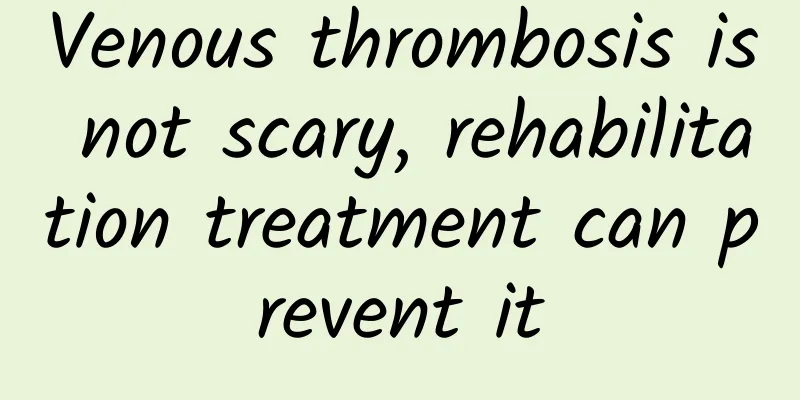Venous thrombosis is not scary, rehabilitation treatment can prevent it

|
Venous thromboembolism (VTE) is a type of thromboembolic disease, including deep vein thrombosis of the lower extremities and pulmonary artery embolism. It has a high mortality rate and seriously threatens human health. Early prevention, early detection, and early treatment can minimize the mortality caused by VTE. Deep vein thrombosis (DVT): When a blood clot forms in the deep vein, it blocks venous return and causes local blood return obstruction, which often occurs in the lower limbs. Pulmonary embolism (PE): Deep vein thrombosis can break off and flow back to the heart along the blood, and then enter the pulmonary artery. The pulmonary artery vessels become smaller step by step like the bifurcation of branches. The broken blood clots flow to the corresponding narrow lumen, blocking the blood vessels, which is called pulmonary artery embolism, or PE for short. Once the symptoms of pulmonary embolism are found, you should lie down immediately, avoid deep breathing, coughing, violent turning, etc., to minimize the possibility of emboli falling off. Call an ambulance immediately and send to the hospital immediately! What conditions are prone to venous thromboembolism? Sitting, standing, or lying in bed for long periods of time, pregnancy, obesity, major surgery, severe trauma, injuries to the spine or pelvis, cancer, congestive heart failure, respiratory failure, and other diseases that lead to a hypercoagulable state of the blood are all risk factors for venous thrombosis. For patients with these high-risk factors, we need to conduct early assessment, monitoring, and strengthen prevention to reduce the incidence and mortality of venous thrombosis and improve the patient's prognosis and quality of life. How to detect venous thromboembolism early? Deep vein thrombosis (DVT): Symptoms may include pain in the calf or arm, swelling (usually on one side), local tenderness, redness or abnormal color of the skin, and increased skin temperature. Pulmonary embolism (PE): chest pain, dyspnea, hemoptysis, and in severe cases, syncope, irritability, palpitations, and even a sense of impending death may occur. However, acute venous thrombosis often lacks specific manifestations. About 70% of patients have no typical symptoms, which is easy to be missed or misdiagnosed. It is often called the "silent killer" and is an important cause of unexpected death in patients. Therefore, for patients with high-risk factors for VTE, evaluation and screening are essential, such as complete blood count (including platelet count and classification), prothrombin time, activated partial thromboplastin time, D-dimer, liver and kidney function tests, and imaging examinations (such as Doppler venous ultrasound, angiography, magnetic resonance imaging, pulmonary ventilation and perfusion scanning, and pulmonary angiography). How is venous thromboembolism treated? Currently, the main purpose of treating venous thrombosis is to eliminate acute symptoms and reduce the incidence of long-term sequelae. Treatment methods include thrombolytic therapy, surgical thrombectomy, lower extremity venous filters, mechanical thrombectomy, and anticoagulation therapy. Among them, anticoagulant therapy can effectively inhibit the spread of venous thrombosis and is the basis for the treatment of venous thromboembolism. Anticoagulants should be used correctly according to the doctor's orders, including low molecular weight heparin, ordinary heparin, vitamin K antagonists (warfarin), rivaroxaban, etc. Attention should be paid to anticoagulant drug treatment: ① If there are signs of bleeding (gingiva, oral mucosa, skin ecchymoses or bleeding spots, hematuria, blood in the stool), please inform your doctor and nurse in time. ② Take medicine on time according to the doctor's orders, quit smoking and drinking, eat a reasonable diet, eat small meals frequently, use a soft-bristled toothbrush, and keep the bowels open. ③ Those who use warfarin should also increase the intake of vitamin K in their diet, such as spinach, carrots, tomatoes, etc. ④ Go to the hospital regularly to check coagulation indicators after discharge. How to prevent venous thromboembolism? 1. Basic prevention: ①Avoid sitting for long periods of time and exercise more: Sitting still for more than four hours is most likely to induce thrombosis. Avoid sitting for long periods of time in your life and work, and don’t forget to stretch your waist, legs and feet. ②Drink more water: Drink more than 2500 ml of water every day to reduce blood viscosity. ③Posture: People who have been bedridden for a long time should raise their lower limbs 20-30cm above the heart, which is beneficial to the return of venous blood in the lower limbs. ④ Ankle pump exercise: Through the ankle pump, blood circulation and lymphatic return of the lower limbs are promoted. Method: dorsiflexion, plantar flexion and rotation of the ankle joint. The patient lies flat, first hooks the toes upward to the maximum extent, with the toes facing the head, and holds for 10 seconds; stretches the foot, presses the toes down as much as possible, and holds for 10 seconds at the maximum extent; rotates the ankle joint for 10 seconds. Repeat all the movements 20 times as a set, 3-4 sets per day. ⑤Others: Try to avoid lower limb vein puncture, quit smoking and drinking, control blood sugar and blood lipids, encourage patients to take the initiative to move, get out of bed as soon as possible, etc. 2. Physical prevention: For people at high risk of venous thrombosis (patients undergoing orthopedic surgery, long-distance flight passengers, people who sit or stand for long periods of time, etc.), it is recommended to wear elastic stockings to prevent venous thrombosis. If conditions permit, an intermittent pneumatic pressure device pump can be used for prevention. Gradient compression stockings (GCS), also known as medical compression stockings or elastic stockings, are a type of stockings with gradient pressure that compresses the legs. The principle is to establish the highest support pressure at the ankle and gradually decrease it upward along the calf, thereby improving the function of venous valves, promoting venous blood return in the lower limbs, and reducing blood stasis. How to wear elastic stockings correctly? Therapeutic elastic stockings are more difficult to wear than ordinary stockings and elastic stockings because they need to have high pressure. First-time wearers only need to be patient and practice a few times to become proficient. It is easier to wear them according to the following reverse pull-up method: a. Put one hand into the sock tube, pinch the heel of the sock, and use the other hand to turn the sock tube to the heel. b. Turn most of the sock tube over and straighten it so that the foot can easily reach the sock head. c. Put the thumbs of both hands on the inside of the sock, grab the sock body with four fingers, put the foot into the sock, and use the thumbs of both hands to hold the sock outwards to tighten the sock. The four fingers and thumbs coordinate to pull the sock towards the ankle and put the heel of the sock in the correct position. d. Turn the leg of the sock back and pull it upwards in sequence. After putting it on, smooth the sock against the body. ② Who should not wear or take off elastic stockings? Suspected or confirmed lower limb arterial ischemic disease; peripheral neuropathy or other diseases that cause sensory impairment; recent skin transplantation, severe skin disease, etc.; heart failure; burns, trauma that damage the integrity of the lower limb skin; leg size is not within the normal range; severe leg deformity. Venous thromboembolism is a common life-threatening disease. Early prevention, early detection, and early rehabilitation are very important for preventing lower extremity venous thrombosis. Let's take action as soon as possible to make venous thrombosis no longer a scary thing! |
<<: Why should I wear hearing aids if my auditory brainstem response is normal?
>>: There are many benefits for babies to lie prone
Recommend
Are gestational sac and fetal sac the same?
Pregnancy is a new stage in life, and there are m...
How many days does ectopic pregnancy bleeding last?
Ectopic pregnancy is an abnormal pregnancy. It ca...
Bleeding one week after menstruation
Bleeding one week after menstruation is an abnorm...
Female dizziness, nausea, fatigue and vomiting
Key reminder: If a 30-year-old woman experiences ...
How is watery leucorrhea treated?
Leucorrhea is like thin water and seems to have n...
What foods can whiten your skin during confinement?
During the confinement period, if women can seize...
Brown blood during menstruation
If brown vaginal discharge occurs during menstrua...
When you are thirsty, what kind of water is the most thirst-quenching? Reminder: 3 kinds of water, the more you drink, the thirstier you become
Water is the source of life, and you must drink e...
What are the effects of drug use during breastfeeding on children?
Everyone knows the great harm of drugs, so the co...
The latest report from China CDC: Since December last year, a total of 12 cases of key mutant strains have been found!
On February 1, the Chinese Center for Disease Con...
Breastfeeding weight loss should master these principles
Breastfeeding is a very healthy method nowadays. ...
Who is not suitable for abortion?
In our lives, there are many people who get pregn...
Qingbitang: 2 methods to effectively help children solve nasal congestion and headaches~
Recently, there have been many messages from moth...
How to reduce acrylamide in food
Recently, the Shenzhen Consumer Council randomly ...









